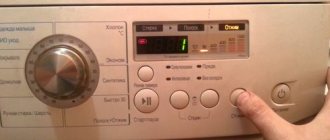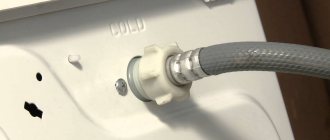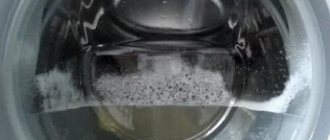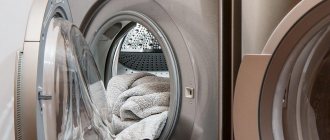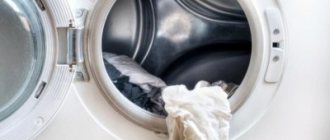The service life of a washing machine depends on three main factors: brand, model, functionality. Various manufacturers claim the service life of their equipment in the range of 5-15 years. However, in practice, poor quality of water and electricity (voltage surges, sudden outages) leads to failures and breakdowns much faster. If it is quite easy to independently diagnose a mechanical failure: by vibration, knocking and other external manifestations, then in a situation where the washing machine does not turn on without any external reaction, it is much more difficult to determine the cause.
There are several main reasons why the washing machine does not turn on:
- There is no electricity in the household electrical network.
- Failure of the power cord.
- The “Power on” button is broken.
- Failure of the hatch locking device.
- Failure of the network filter.
- Malfunctions of internal wiring elements.
- Failure of the control module.
There is no electricity in the household electrical network
Let's simulate an unpleasant, but, unfortunately, typical situation. The drum is loaded, the powder is poured in, we insert the plug into the socket, but the automatic washing machine does not turn on, moreover, it does not react at all. First, it is necessary to exclude the influence of external factors, which are detected by the operation of a machine or RCD.
Electrolikbez!
For those who are not very versed in electromechanics, I will give a short explanation. A residual current device (RCD) is triggered if a leakage current occurs in the apartment's electrical network. That is, a terminal has become unscrewed in one of the electrical appliances, and the wiring supplies current to the housing. It is the RCD that protects the user from electric shock, and the wiring from overheating and fire. The machine (circuit breaker) disconnects the circuit in the event of a short circuit or overload. There is a third type - a differential switch that combines the functions of an RCD and an automatic circuit breaker.
Difavtomat
The first thing to do is unplug the washing machine from the socket. Then go to the apartment's electrical distribution panel and look at the position of the lever in the automatic machine. If necessary, move it from the “Off” position. (off) to “On” position (on). After turning on the difavtomat, we repeat the attempt to activate the socket, but using another device. For example, a table lamp. If the automatic circuit breaker works again, then the problem is in the socket. Its serviceability can be checked with an indicator screwdriver: the indicator should light only when in contact with one hole. When checking with a multimeter, the device is set to AC mode - ACV and the value is 220 V. The corresponding indicators should appear on the display. If the readings of the testing devices differ from the standard ones, then water has probably entered the outlet or the wires have burnt, and it needs to be replaced. If everything is fine with the socket, then the problem is in the washing machine.
IMPORTANT!
Do your own electrical wiring repairs only if you are 100% sure of the quality result. Otherwise, it is better to invite a specialist.
Simple reasons that you can deal with yourself
Stopping and freezing are not always associated with global problems. It happens that due to inattention, the user chose the wrong cleaning mode, put things in the drum incorrectly, or the drain hose became bent/clogged. These and many other faults can be easily fixed with your own hands.
Program selection error
This problem is usually encountered in the middle of the wash cycle. The machine started working as usual: it heated the water, carried out a preliminary and main wash, and suddenly went silent. In this case, the door is blocked and the water does not drain.
In this case, you need to check which operating mode of the device is set. If it is a “delicate” or “hand wash”, then the drainage and spinning are automatically turned off. Simply turn the mode switch to the desired position and repeat the washing process. Some machines have an additional rinse and spin function. Using this option, you will be able to complete the wash.
Overload of laundry
Overloading a washing machine causes a lot of troubles, some of which will be noticeable immediately, while others will appear after some time. If the washing machine freezes immediately after turning on and selecting a program, you need to check whether there is too much laundry loaded into the spinner.
It is very important to ensure free rotation of the laundry in the drum of the machine. This is the only way to achieve uniform distribution of water and powder, and therefore better cleaning quality
An overloaded drum puts great force on the bearings of the device, which can result in failure or breakdown of the unit.
Before you start using a new appliance, you should read the instructions about the norms and rules for loading laundry. Each machine is equipped with a special sensor that monitors the weight of the drum with laundry and will not allow washing to start if it is overloaded.
To correct the situation, you need to turn off the machine and take out some of the things, postponing cleaning them until next time.
Imbalance
When loading laundry into the machine, you must not only follow the weight recommendations, but also ensure that the items are evenly distributed in the drum. If the machine has filled with water, turned the drum several times, but is not going to start washing, you can suspect the presence of an imbalance.
The cause of this problem may be improper loading of clothes and other things into the machine. Before washing, buttons and zippers on the products are fastened, items with Velcro are placed in special bags, and bulky rugs, pillows and blankets are washed separately.
You can deal with the problem as follows:
- disconnect the device from the network;
- drain the water using the drain filter located at the bottom of the unit;
- open the hatch;
- sort out the laundry, arrange things evenly in the centrifuge.
After this, you can set the desired program and restart the device.
Clogged water supply or drainage system
If the washing machine does not switch from wash to rinse mode, it can be assumed that the drain filter, pipe or drain pump is clogged. Waste water carries with it threads and lint, particles of dust and dirt, and sometimes much larger debris, such as coins, pins, paper clips that have fallen out of pockets.
To prevent this “wealth” from entering the sewer pipe, a drain filter is provided. Over time, it becomes so clogged that it is unable to pass water. As a result, the unit does not switch to rinse and spin mode, and the washing cycle stops.
In this case, you need to determine where exactly the fault is hidden: in the machine, the drain hose or the general sewer.
- Inspect the drain hose and straighten any kinks.
- Eliminate the possibility of blockage in the sewer. To do this, the end of the drain hose must be disconnected from the sewer pipe and directed into a bathtub or bucket. Start draining the water. If the water still does not drain, then there is a problem with the machine. Otherwise, you need to clean the sewer pipe.
- Remove and clean the filter located in the lower right corner of the device.
This simple procedure will bring the device back to life. If you empty your clothing pockets of debris and small items before washing, you will need to clean the filter no more than once a year.
Failure of the power cord
Various wire defects are among the most common reasons that the washing machine does not turn on. The reason is that the wire is constantly deformed during operation: it is bent, pinched, stretched. It is not uncommon for it to be chewed by pets. Failure of a wire or plug is determined visually by the presence of significant thickening and discoloration of the insulation, mechanical damage, traces of melting, etc.
Burnt out socket
I strongly recommend replacing the wire completely, rather than repairing it with electrical tape. You need to buy a new wire with a solid plug. After removing the back panel of the washing machine, get to the connection point. In most modern models, the wires are connected to the washing machine using conventional terminal attachments. Before disconnecting the old wire, be sure to take a photo of the connection location so you don’t get confused with the wire markings later.
Power cord
Damage to the "Power" button
What to do if the indicators on the washing machine do not light up and it does not turn on. With a high degree of probability, the malfunction may lie in the “Power” button (Start, Start). This breakdown is typical for new models with push-button control. Checking the functionality of this button is done as follows:
- The washing machine is disconnected from the power supply.
- The top panel is removed: two screws from the self-tapping screw are unscrewed from the back and the cover is slightly pushed forward.
- The control panel is removed: the powder tray is pulled out, the screws that close it are unscrewed. The plastic latches bend and the panel rises slightly.
- The connection point of the “Power on” button is photographed and it is disconnected from the wires.
- The contacts are carefully connected directly, after which the washing machine is plugged into the outlet. If the power indicators light up and the washing machine starts executing the program, then the problem is in the button.
IMPORTANT!
When testing, it is necessary to completely eliminate the possibility of contact of the connected terminals with the machine body.
Power buttons
If the reason that the automatic washing machine does not turn on is the button, you do not need to immediately run out to buy a new one. There is a high probability of it sticking due to contamination. First you need to clean the inside surfaces of the button hole in the control panel. To do this, you need to completely remove the control panel and disconnect the board from the plastic facade. Naturally, the connection points of all wires must first be photographed. The plastic cover is cleaned using household chemicals. In this case, it is recommended to additionally clean the control board from dust and wipe the contacts with alcohol.
SMA turns on but does not work
If the Indesit, Hansa, Virpul and other models turn on but do not work, the reason is the UBL lock. The machine does not start the wash because the electronic lock or its wiring is broken.
In addition to the usual lock, the washing machine system is equipped with an electronic lock. After closing it, you should hear the door click. If this does not happen, the electronic module does not receive a signal, so the wash does not start. In this case, the indicators do not light up, the “Lock” light may blink.
As soon as the door is locked, you will immediately hear the noise of water intake.
How to check UBL:
- Open the hatch door.
- To get to the lock, you need to remove the hatch cuff clamp.
- To do this, bend the sealing rubber and remove the clamp.
- Tuck the cuff inside the tank.
- Unscrew the two lock screws.
- Reaching behind the body, remove the lock.
- Disconnect its wires.
Using a multimeter, measure the resistance of the lock on the contacts; if it is faulty, install a new part.
Wiring problems
Check the CMA wiring. If it does not burn out, the connectors may become loose due to strong vibration of the machine. A thorough inspection and testing with a multimeter is required. In the event of a breakdown, the wiring is replaced completely or partially.
This is interesting: Do-it-yourself TV repair: causes of malfunction, detailed instructions
Failure of the hatch locking device
If the power indicator on the washing machine is on, the control module allows you to select a washing program, but after activating it, an error message like “Error” appears on the display, then you need to check the functionality of the hatch locking device - UBL. It is a latch whose operating principle is based on the movement of a bimetallic plate. Long-term use and constant temperature changes can deform the plate and damage the device.
The first sign of a UBL malfunction is the absence of a click when closing the loading hatch door. For a deeper check, you need to partially disassemble the washing machine and disconnect the device. This is done as follows:
- The fixing clamp is removed from the hatch cuff.
- The cuff is bent from the UBL side.
- The two fixing bolts are unscrewed and the lock mechanism is removed from the inside.
- The wires are disconnected.
- The value is measured on the lock contacts with a multimeter.
If the UBL is faulty, then we replace it with a new one. The cost of such a part is quite low, and there is no particular need for repairs. If the blocker is working, then the reason for the failure of the washing machine may lie in the electronic control unit or command device.
UBL
There are cases of UBL failure during the washing process, or when the hatch door is closed. To unlock the door, you need to remove the top cover of the washing machine and press the door latch protruding from the hole on the back of the lock.
In some cases, the terminals of the connector connected to the blocker burn out. They need to be replaced, since a poor connection between the contacts quickly leads to repeated burnout of the device.
A special case
In some situations, the automatic machine turns on normally and the washing process starts as usual. Only during operation can the device turn off completely, and then it can no longer be turned on. If this is exactly the case, you must do the following:
- unplug the machine from the outlet;
- check the level of its installation and the distribution of things in the drum;
- open the hatch door using the emergency cable, arrange the items evenly on the drum and remove some of them from the machine;
- close the hatch tightly and turn on the device again.
Such simple steps should help solve the problem that occurs due to improper installation of the device or its overload.
If they do not bring the desired result, and other methods of solving the problem do not help, you should contact the service center for specialist help. Trying to start the machine yourself in such cases is not recommended.
Line filter failures
Each modern model of washing machine has a device such as an interference filter or surge protector. It is designed to smooth out electromagnetic pulses resulting from the operation of the electric motor and heating element. If the mains filter breaks, the washing machine does not turn on or off. In some cases, the network indicator may be on, but the programmer does not respond to commands. The second situation can also arise when the programmer (control module) or command device fails. But since these devices are quite expensive and difficult to repair, it is necessary to first exclude all other faults.
Diagnosis of a network filter malfunction is carried out as follows:
- The washing machine is disconnected from the power supply.
- The screws around the perimeter of the rear panel are unscrewed, after which the case cover and rear panel are removed.
- A multimeter is used to test the contacts of the interference filter in resistance measurement mode.
It should be noted that the interference filter cannot be repaired, and in the event of failure, only replacement is necessary. Purchasing new parts is not particularly difficult, since their characteristics are similar for entire model series.
Network filter
IMPORTANT!
In fact, the washing machine can operate without an interference filter. To do this, the contacts from the power cord are directly connected to the outgoing wires coming from the filter (as shown in the photo). But this method of “repair” can lead to dire consequences. The interference filter also protects the internal elements of the washing machine from external influences (voltage drops): control board, wiring, heating element, electric motor.
Replacing the filter is quite simple:
- The place where the wires are connected is photographed.
- The incoming wires from the power cord and the outgoing wires to the command device are removed.
- The bolts securing the element to the body of the washing machine are unscrewed.
- A new filter is installed, all terminals are connected to its connectors in the same order.
The drum stopped spinning
The device may show various signs of failure. They signal various malfunctions:
- You can hear motor noise and relay clicks. The machine fills and drains water, but the drum stands still. This occurs when the drive belt breaks. It transmits torque from the motor to the drum.
- The drum can be swung freely by hand, but it is loose. Bearings are worn out. Several cycles before the drum stops spinning completely, the machine will make loud noises and spin poorly.
- The motor noise is not heard, the display shows a tachometer error. This element reduces the speed at which the motor rotates the drum.
The washing machine may stop spinning the drum if the motor breaks down. The brushes that transmit torque may be damaged and worn out.
Malfunctions of internal wiring elements
If, after turning on, the washing machine immediately turns off or does not perform one or more functions, then it is highly likely that damage to the internal wiring or control unit can be diagnosed. Breakage or burnout of internal wires, as a rule, occurs in budget models of washing machines from little-known Chinese manufacturers. Determining which wire has failed is quite difficult. Moreover, they may not burn out, but simply fall out of their sockets. To determine connection locations, you need to be able to read diagrams. To identify a burnt wire, you must have skills in working with a tester. In any case, to identify damage to the internal wiring, it is necessary to completely disassemble the washing machine body.
Failure of the control module or command device
The selection and launch of the functions of the washing machine is carried out by an electronic module or a command device (programmer) in models with analog control. Diagnosis of malfunctions of these devices is carried out only after all other options have been excluded, and the washing machine turns off anyway. These are the most expensive components, which are also difficult to repair at home.
Control module
As for the control board, the maximum that can be done without an electronics engineer’s education and a special soldering station for microcircuits is to remove the device and carefully inspect it for physical damage and contamination of contacts, as well as swollen capacitors.
If, with sufficient experience and dexterity, you can try to re-solder the capacitors yourself, then a burnt-out microcircuit can only be replaced at a service center. However, in most cases, such repairs will be comparable in cost to ordering a new control board.
ADVICE!
The electronic module and programmer are quite expensive parts. Therefore, if you are not sure about their malfunction, it is recommended to send it to a service center for diagnostics.
Command apparatus
The command device is used on washing machine models with control knobs. To diagnose and repair it (or rather prevent it), perform the following steps:
- Remove the front control panel and the cover of the washing machine to gain access to the device.
- Disconnect the command device, having previously photographed the location of the connection wires.
- Completely disassemble the device. By pressing the plastic latches on the sides of the case, you can remove the cover and disconnect the board.
- Inspect the board thoroughly and if you find burnt tracks, solder them.
- Clean all contacts and measure their resistance with a multimeter.
- Disconnect the center gear from the core.
- Thoroughly clean the nest from dust, treat the gears with alcohol and reassemble in reverse order.
IMPORTANT! For most modern models of washing machines, if analog control is combined with a large number of functions, the programmer is too complex and cannot be repaired.
What to do to avoid problems with your washing machine
To ensure that your household assistant lasts as long as possible, we recommend that you read and remember our tips:
| What to do? | Consequences and solutions |
| Take care of the heating element | To prevent it from overheating due to accumulated scale, install an inlet filter on the heating element |
| Clean the hose mesh regularly | This filter traps large pieces of rust and other elements. If the mesh is clogged, water may not flow well into the washer. |
| Do not overload the device and check your clothing pockets | Small items, buttons and other items can cause damage |
| Do not connect the machine to a hot water supply. | Such a trick in order to save money will only squander finances and entail additional expenses for repairing the device. |
| Take care of the safety of the unit during power surges | To do this, you need to purchase a stabilizer that will prevent damage to the washing machine from power supply fluctuations. |
| Remove washed laundry as soon as the program stops | Do not leave it in the drum to prevent mold from forming. You should also leave the machine door open after washing to allow moisture to evaporate, and wipe the seal with a dry cloth. |
By following these tips, you will extend the life of your washing machine and prevent many problems from occurring.
If your household assistant suddenly refuses to work, there is no need to despair. A careful inspection and timely replacement of damaged parts can, in most cases, bring the washing machine back to life before the technician arrives. Get a repair kit and instructions for your model, and you will succeed.
Note: Top-loading washing machines: review of the top 5 best




